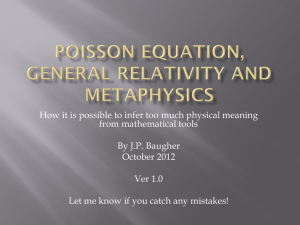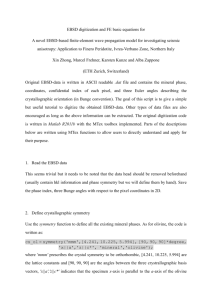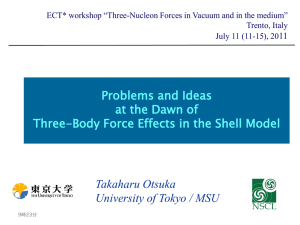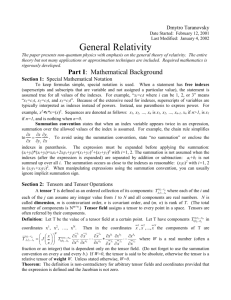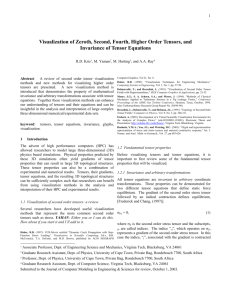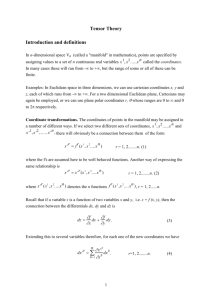Hideki Yukawa and Nuclear Physics
advertisement
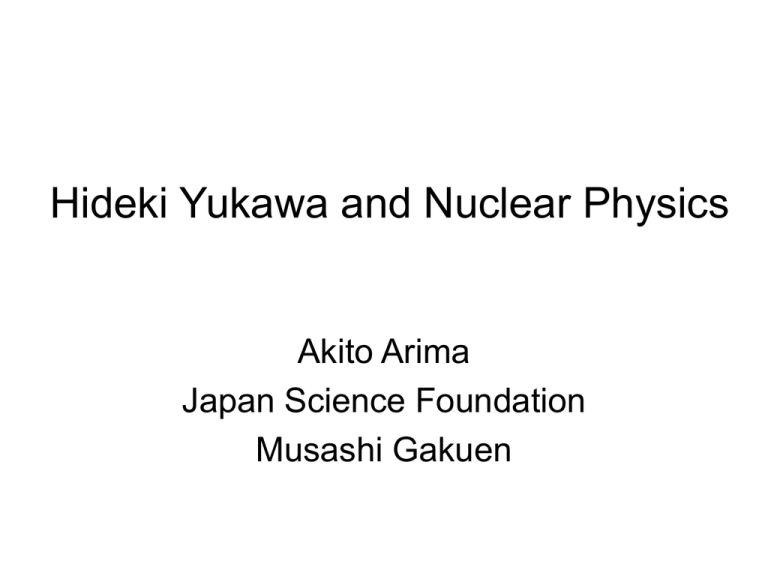
Hideki Yukawa and Nuclear Physics Akito Arima Japan Science Foundation Musashi Gakuen 1 Professor Hideki Yukawa has encouraged Japanese, especially young Japanese, just after the Second World War. 2 Professor Hideki Yukawa’s creation of a new academic system for research in fundamental science: The inter-university research institutes. 3 Pions, nuclear interaction and nuclear structure. 1 Professor Hideki Yukawa has encouraged Japanese, and especially young Japanese, just after the Second World War. 毎日新聞社提供 毎日新聞社提供 出典:TIMEアーカイヴス 出典:毎日新聞の好意による 毎日新聞社提供 2 Professor H. Yukawa’s creation of a new academic system to research fundamental sciences; inter-university research institutes Institute of Fundamental Physics in Kyoto University The first inter-university research institute Examples of inter-university research institutes Cosmic ray laboratory (super Kamiokande) Institute of Nuclear Study KEK etc. The most important driving forces to develop research of fundamental sciences and technologies in Japan Workshops, Winter and summer schools have been organized in Institute of Fundamental Physics. 3 Pions, nuclear interaction and nuclear structure 3-1 Nuclear magnetic moments A difficult problem in 1950 was the magnetic moment of 209Bi. Ⅰ Nuclear Shell Model 1 Magic Number Z=2(He), 10(Ne), 18(Ar), 36(Kr), 54(Xe), 86(Rn) They are rare gases. Nuclear magic numbers Z=2,8,20,50,82 N=2,8,20,28,50,82,126 0 2g9/2 1i11/2 3p1/2 2f5/2 2f7/2 1h9/2 3s1/2 1h11/2 2d6/2 1g7/2 1g9/2 2p1/2 2p3/2 1f5/2 1f7/2 2s1/2 126 Hartree-Fock potential (MeV) -10 82 -20 50 -30 20 1i13/2 2d3/2 1d3/2 1d6/2 -40 8 1p1/2 1p3/2 2 -50 -60 3p3/2 1s1/2 0 2 4 6 Nuclear radius(10-15m) 8 10 208Pb is very stable, because Z=82 and N=126 which are magic numbers. Pb 208 82 Bi 209 126 Pb Very stable 208 208 Pb+b This proton in h9/2 -shell is expected to rotate freely about the center of 208Pb. The operator of magnetic moment gs s + g The Schmidt value s ( j) j( g j gs g 2 1 ) 1 2 g 1 g 0 g s 5.585 for proton g s - 3.826 for neutron unit n.m. μs(h9/2)=2.62 n.m. μobs (209Bi)=4.11 n.m. δμ=μobs-μs =1.5 n.m. Very large. A serious problem in 1950. Pi-meson exchange current Pi-meson(π)was Predicted by Yukawa in 1935. π meson was discovered experimentally by C.F.Powell. π +, π 0,and π Pi-meson exchange currents H.Miyagawa 1951 Villars 1952 2 Nuclear Shell Model Mean field theory with strong spin-orbit force s Mayer and Jensen 1949 Shell model level scheme (mean field approximation) A strong spin-orbit interaction is necessary to explain the magic numbers the jj-coupling shell model of Jensen and Mayer! l magic number ×× 1 j<=ℓ- 2 ×××× 1 j>=ℓ+ 2 16 O , 40 Ca M1-Giant Resonance ×× ××× ○ Impossible because j<-orbit is closed. 1 j<=ℓ- 2 magic number ×××××××××××× 208 1 j>=ℓ+ 2 Pb (The Ground state O ) + × Possible j< is vacunt ×××××××××××○ 208 Pb (M1-Giant 1+) h11/2 → h9/2 protons i13/2 → h11/2 neutrons ( 9 i B 126 83 209 2 ) ( 208 P b(0 ) h 9 / 2 ; 9 + 2 208 + ( P b(1 ) h 9 / 2 ; 9 ) 2 ) ( ) 0 Configuration Mixing = Core-Polarization (Bohr and Mottelson) ( 209 B i) ( B i) 0 h9/2 2 0 h 9 / 2 ,9 2 2 0 h 9 / 2 ,9 , 9 0 h 9/2 , 9 2 1 h 2 9/2 ,9 2 1 h 0.8 n.m . CM 9/2 ,9 2 ( ) s 2 2 0 cm obs 17O 0 0.02 17F 0 -0.08 41Ca 0 0.32 41Sc 0 -0.37 209Bi 0.8 1.5 Nucleus Chemtob in 1967 found that the pi-meson exchange current modifies g . g 0.10 for proton g 0.10 for neutron M EC ( h 9 / 2 ) 0.5 n.m . theory B i) C M M E C 0.8 0.5 1.3 obs ( 209 Bi) 1.5 n.m . n.m . δ Magnetic moment of 209 83 Bi126 1.49 1.5 1.37 MEC 2nd order C.P. 1 1.05 Crossing C.P. × MEC 0.79 0.5 1st order C.P. 0 Ref.: A.Arima, K.Shimizu, W.Bentz, H.Hyuga Adv. Nucl.Phys. 18 (1987) 1. OBS Most important contributions to the magnetic moment of 209Bi : (1) first order configuration mixing =first order core-polarization C P C M (2) one pi-meson exchange current Yamazaki, Nagamiya, Nomura and Katou in 1970 confirmed experimentally g 0 .1 fo r p ro to n s an d g 0 .0 9 fo r n eu tro n s The contribution of pi-meson current is experimentally confirmed. 17O, 17F, 41Ca and 41Sc obs are small, and C M 0 But obs are not zero. GT transition rates deviate from their shell model values. Therefore higher order corrections, such as second order configuration mixings, must be considered: Shimizu, Ichimura and Arima in 1974, Towner and Khanna in 1979. δ ISOSCALAR MOMENT 2nd CROSS MEC -hole δ ISOVECTOR MOMENT -1 p 1/2 17 d 5/2 39 -1 d 3/2 41 f 7/2 Ref. : I.S.Towner, F.C.Khanna, Nucl.Phys. A339 (1983) 334. GAMOW - TELLER δ 0.2 0 (GT) -0 .2 REL 2nd CROSS MEC -hole -1 p 1/2 17 d 5/2 39 -1 d 3/2 Ref. : I.S.Towner, F.C.Khanna, Nucl.Phys. A399 (1983) 334. 41 f 7/2 GT transition rates s s s s 2 obs 2 obs 2 shell m odel 2 1 2 are observed by using the (p,n) reaction. (Goodman et al (1980)) This quenching has been explained by h o le e ffe c t. is the isobar of nucleon. ( 300 M eV excitation energy ) The effect of the second order configuration mixing (= 2 particle -2 hole mixing) was not believed. Why is quenched ? hole m ixing 2p-2h or 2p-1h mixings (second order configuration mixing) Simple shell model h s ta te s ( 300 M eV ) 2p-2h or 2p-1h states 50 % of strength spread over 20 50 M eV 0p-0h or 1p 100 % of stre n g th 1p-1h or 1p states 0p-0h or 1p 50 % of stre n g th 1p-1h or 1p states Bertsch, Hamamoto Shimizu et al Towner, Khanna 0p-0h or 1p 1p-1h or 1p states 90 Zr(p,n) exp (K.Yoko, H.Sakai et al.) Rijsdijk, Dickhoff et al . Dang, Arima et al . IVSM 90 Zr(n,p) IVSM Ref. : K.Yoko, H.Sakai et al, Phys.Lett.B615 (2005) 193. Comparison between experimental and theoretical results for GT strength distributions • (p,n) Calc. with 2p2h • Bertsch,Hamamoto PRC 26 1323 (1982) • Dang, Arima et al. PRL 79, 1638 (1997) – Fairly good agreement with experimental results in contituum – Exp. > Theory → IVSM • (p,n) and (n,p) Calculations • DRPA by Rijssijk et al.PRC 48, 1752 (1993) IVSM IVSM IVSM – Good agreement in low w (GT) – Exp. > Theory in high w → IVSM IVSM should be subtracted to evaluate GT quenching Q GT Quenching Factor Q after Subtraction of90IVSM • Final Values (Up to 50 MeV of – Total GT strengths Nb) • S 28 . 6 0 . 6 ( stat MDA ) 0 . 9 ( IVSM ) 1 . 7 (ˆ GT ) • S 2 . 8 0 . 5 ( stat MDA ) 0 . 3 ( IVSM ) 0 . 2 (ˆ GT ) – GT sum rule • S S 2 5.8 0 . 7 ( stat MDA ) 0 . 7 ( IVSM ) 1 . 5 (ˆ GT ) – Quenching Factor Q 0.86 0.02(stat MDA) 0.02(IVSM ) 0.05(ˆ • Inaccessible errors in TRIUMF data Previous Q 0 . 90 0 . 05 ( stat MDA ) ..... GT ) 0 . 15 (ˆ GT ) Our final(latest) result Q 0 . 86 0 . 07 (quadratic sum of uncertainties) One-p + two-p exchange potential Central One-p exchange Two-p exchange Tensor One-p exchange Two-p exchange Tensor Operator M. Taketani, S. Machida, and S. Onuma: Prog. Theor. Phys. 7 45 (1952) Summary: Most important parts of the nuclear force Short Central force Tensor force Spin-orbit force Intermediate Long range VT ( r 12 ) S 12 Y (2) (2) 12 , 12 0 f ( r12 ) where (2) S 12 Y (2) s1 s 2 2 , spherical harm onics f ( r12 ) a function of relative distance r 1 2 S (2) Y (2) (0) 3( s 1 r ) ( s 2 r ) / r s 1 s 2 2 The deuteron wave function has the form N u (r )Y (0) ( ) (1) w ( r ) Y (2) ( ) (1) (1) where N is a normalization constant, u(r) and w ( r ) (1) are radial wave functions , and are the spin wave functions of the two nucleons: (1) 1 2 1 2 1 2 / 1 2 2 observed OPEP The quadrupole moment of the deuteron confirms that the deuteron is not spherical. This is the best evidence of the tensor force. Deuteron Q 3z r (2) 2 2 0 z-axis 3S 1 3D 1 state state z-axis = + 0.03× Deformed rotor Tensor force mixes 3S1 and 3D1 states z-axis Q (2) 3z r 2 2 0 The first order effect of the tensor force is zero between a valence nucleon and the core 16O or 40Ca, in which both j a n d j a re clo se d . This is because m agic num ber S si 0 i 1 L i 0 i w h e n b o th j l 1 2 a n d j l 0 3 (s i i 1 a re clo se d , a n d th e re fo re 2 0 rik )( s k rik ) ( s i s k ) 0 . The second order effect of the tensor force suggested by Wigner in 1950. Arima and Terasawa calculated the second order effect of the tensor foce in OPEP. in 17O -meson weakens the tensor force. The second order effect of the tensor force could be 1/3 ~ 1/4 of the spinorbit interaction. 51Sb isotopes (Proton SPE) Energy [MeV] J. P. Schiffer et al., Phys. Rev. Lett. 92 162501 (2004) 1h11/2 1g7/2 64 70 Neutron number 82 The first order effect of tensor force on V s s ( < 0 in sh e ll m o d e l) : change of occupation j 2 orbit is being occupied 1 S 0,L 0 j 2 orbit is being occupied 1 S 0,L 0 j is c lo s e d after two orbits j a n d j a re clo se d S 0,L 0 Shell model requires 0 , w here is the strength of the spin-orbit interaction : V s s The first order effect of the tensor force weakens the spin-orbit interaction when valence nucleon levels are being occupied. j 1h11/2 j ’ Single particle energy of protons 1g7/2 j j h 11 / 2 h9/2 is being occupied is being occupied Sb isotopes (Proton SPE) T. Otsuka, T. Matsuo, and D. Abe, Phys. Rev. Lett. 97 162501 (2006) J. P. Schiffer et al., Phys. Rev. Lett. 92 162501 (2004) 1h11/2 1h9/2 Summary: Most important parts of the nuclear force Short w Intermediate Central force Tensor force Spin-orbit force p w Long range p In summary, I discussed the contributions of Professor Hideki Yukawa in fostering and encouraging young researchers and this contributions to promote fundamental sciences, especially by establishing interuniversity research institutes in Japan. I then discussed nuclear magnetic moments where the one pi-meson exchange current plays a very essential role together with the configuration-mixing effect. The tensor force is of the most important Consequences of the pion exchange potential. The best evidence is provided by the deuteron. The g7/2-h11/2 spacing of proton levels in the Sb istopes also provides an evidence of the tensor force. Thus pions predicted by Professor H.Yukawa still plays important role in nuclear physics today.


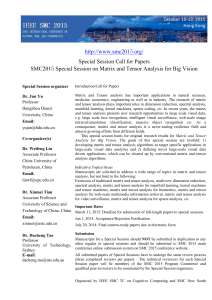


![The Politics of Protest [week 3]](http://s2.studylib.net/store/data/005229111_1-9491ac8e8d24cc184a2c9020ba192c97-300x300.png)

